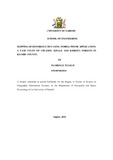| dc.contributor.author | Tuukuo, Florence | |
| dc.date.accessioned | 2018-10-22T07:01:01Z | |
| dc.date.available | 2018-10-22T07:01:01Z | |
| dc.date.issued | 2018 | |
| dc.identifier.citation | Master of Science in Geographic Information Systems | en_US |
| dc.identifier.uri | http://hdl.handle.net/11295/104309 | |
| dc.description.abstract | Deforestation and forest degradation monitoring is one of the central elements for Reducing Emission from Deforestation and Forest Degradation, sustainable management of forest, enhancement of forest carbon stock and conversion of existing forest carbon stock implementation. The current schemes for detecting and monitoring deforestation are based on remote sensing and field measurements. Monitoring being a periodic process of assessing the properties of forest stands with respect to some reference data. This project presents a conceptual framework and process that aims to simplify the forest monitoring capacities of local communities in developing countries in which mobile phone application is used based on a case study Kiambu County Kenya. The objectives of this research included: Provision a platform by identification of nature and extent of deforestation which can be used by Kenya Forest service. Testing and validation of mobile phone application as an efficient and fast method for monitoring deforestation. Assessment of forest change activities within the forest that lead to deforestation i.e. drivers of deforestation and determination of the usability of mobile application in assessing and monitoring deforestation.
Adopting the current schemes for implementing monitoring at national levels is a challenging task. Recent advancement of Information and Communications Technologies (ICT) and handheld devices has enabled local communities to monitor their forest in an efficient and cost-effective way. The GIS cloud mobile application in this study demonstrated the potential to be used for mapping deforestation and makes data collection easier as well as enables better forest management. It is able to integrate location-based services with digital orientation which makes wireless communication and remote sensing technologies for low-cost solutions for geospatial data collection and ground truthing. The results enabled the determination of major drivers of deforestation which include; Logging, infrastructural development, forest to agriculture land conversion and unplanned settlement. The mobile phone application was efficient for this research and this project recommends that the forestry sector should take it into account as it is effective within reachable means. | en_US |
| dc.language.iso | en | en_US |
| dc.publisher | University of Nairobi | en_US |
| dc.rights | Attribution-NonCommercial-NoDerivs 3.0 United States | * |
| dc.rights.uri | http://creativecommons.org/licenses/by-nc-nd/3.0/us/ | * |
| dc.title | Mapping of deforestation using mobile phone application: a case study of Uplands, Kinale and Kereita forests in Kiambu county | en_US |
| dc.type | Thesis | en_US |



